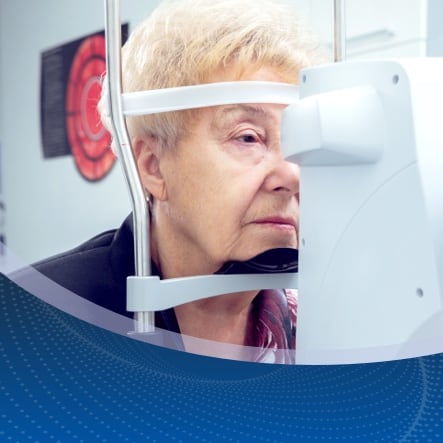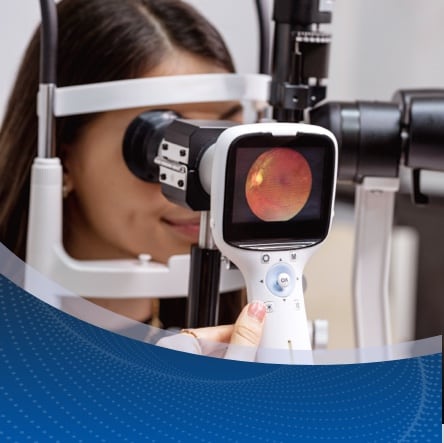Reviewed By: Dr. Paul M. Griffey
Have you ever tried looking through a paper towel roll or a straw? That’s what tunnel vision can feel like. It’s a type of peripheral vision loss that narrows your field of view, making it hard—or sometimes impossible—to see anything that isn’t directly in front of you.
Whether it comes on suddenly or gradually, tunnel vision can be alarming. Griffey Eye Care & Laser Center knows that understanding what’s happening is the first step to protecting your vision. Let’s walk through what tunnel vision really means, what causes it, and how it can be treated.
What is Tunnel Vision?
Tunnel vision is a condition where your peripheral vision—the side vision you normally rely on for seeing motion or navigating your surroundings—is weakened. Medically, it’s called peripheral vision loss (PVL). Your central vision may still be intact, which means you can read, drive forward, or look at someone directly, but the world outside your direct line of sight looks blurry or invisible.
Using an analogy, if your normal visual field is a wide window, tunnel vision turns that view into a narrow hallway.
What Does Tunnel Vision Look Like?
People experiencing tunnel vision often describe it as looking through a narrow tube. You might not notice what’s off to your sides, bump into things, or feel disoriented in crowds. Some people also report trouble seeing in dim lighting or at night.
Here are some common signs that may point to tunnel vision:
- Bumping into objects or walls
- Difficulty getting around in busy areas
- Trouble driving or changing lanes
- Constantly needing to turn your head to see what’s around you
- Struggling with low-light environments
It may affect one or both eyes, and can come on suddenly or develop gradually, often so slowly that your brain adjusts without you realizing there’s a problem.
What Causes Tunnel Vision?
Tunnel vision is not a disease itself. It’s a symptom of an underlying condition. Some of the most common causes include:
Eye-Related Conditions:
- Glaucoma: The most common culprit, often developing silently over time as increased pressure in the eye damages the optic nerve.
- Retinitis Pigmentosa: A group of inherited disorders that affect the retina’s ability to process light.
- Diabetic Retinopathy: High blood sugar damages the blood vessels in the retina.
- Retinal Detachment: A medical emergency where the retina pulls away from the back of the eye.
- Optic Neuritis: Inflammation of the optic nerve, sometimes linked to autoimmune conditions.
Learn more about retina conditions at Griffey.
Other Health Conditions:
- Migraine Auras: May cause temporary vision narrowing or loss.
- Stroke or Concussion Can affect the parts of the brain responsible for processing vision.
- Carotid Artery Disease: Restricted blood flow to the eyes or brain can lead to vision issues.
- High Blood Pressure: Over time, it can damage the eye’s blood vessels.
Some causes of tunnel vision are temporary and treatable. If left untreated, others may progress to permanent peripheral vision loss.
Can Tunnel Vision Be Treated?
Yes, but treatment depends on the cause.
- If caused by glaucoma, medications, laser therapy, or surgery may help lower eye pressure and preserve vision.
- Inflammation-related cases, like optic neuritis, may improve with steroid treatment.
- Retinal tears or detachments often need immediate surgery.
- For migraines or high blood pressure, you must manage the underlying condition.
The earlier tunnel vision is diagnosed, the more treatment options you’ll have. That’s why regular eye exams are so important.
When Should You See an Eye Doctor?
If you notice any changes to your vision, especially sudden loss of side vision, it’s time to call your eye care provider. In some cases, tunnel vision can signal a medical emergency.
Call us immediately if you experience:
- Sudden tunnel vision in one or both eyes
- Severe eye pain
- Flashes of light or new floaters
- A recent head injury followed by visual changes
Griffey Eye Care & Laser Center’s experienced team can perform visual field tests and other diagnostics to find what’s going on and guide you toward the right treatment.
How to Protect Your Peripheral Vision
Good eye health is a lifelong habit. Here are a few ways to protect your vision and potentially prevent tunnel vision:
- Schedule regular comprehensive eye exams (especially if you’re over 40 or at high risk)
- Manage chronic conditions like diabetes or hypertension
- Don’t ignore migraines or vision disturbances
- Wear sunglasses to shield your eyes from UV damage
- Avoid smoking and limit alcohol intake
- Maintain a nutrient-rich diet with antioxidants, omega-3s, and leafy greens
Book Your Appointment!
Tunnel vision can be disorienting, especially when it comes on suddenly, but it doesn’t have to mean the end of your sight. With early detection and expert care, many causes of peripheral vision loss can be managed or even reversed.
If you or someone you love is experiencing tunnel vision, we’re here to help.
Call Griffey Eye Care & Laser Center at 1-888-873-9348 or schedule a consultation.
**Please note that the suggestions provided in this blog are for general informational purposes only and may not be suitable for your specific insurance plan and vision needs. It is important to consult a qualified healthcare professional for personalized advice and treatment.**












